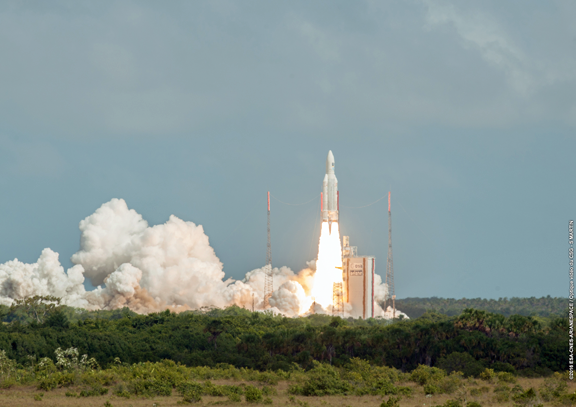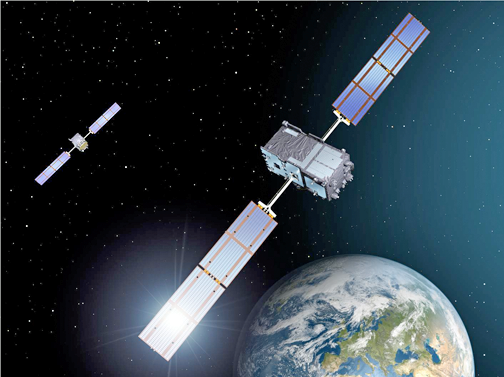

An Arianespace Ariane 5 launch vehicle has successfully placed four satellites into orbit, thereby completing the European Galileo satellite navigation constellation.
This was the 75th time an Ariane 5 has completed a mission from the European space port in Kourou, French Guiana. This 233rd launch noted that the upper stage for this Ariane 5 mission was powered by the re-ignitable Aestus engine, which has already been used successfully for launches of the European ATV space vehicle.

The Ariane 5 launch of flight VA233 with a payload of
four Galileo satellites.
Photo is courtesy of Arianespace.

Artistic rendition of Galileo satellites.
The Ariane 5 launcher once again demonstrated full flexibility, which enabled the rocket to carry heavy payloads into LEO, two satellites into geostationary transfer orbit, a single satellite with an optimized service lifetime, or several satellites to MEO, as was the case today.
Airbus Safran Launchers is lead contractor for the Ariane 5 launchers. The company coordinates an industrial network of more than 550 companies in 12 European countries (including more than 100 small and mid-sized Enterprises - SMEs). Airbus Safran Launchers oversees the entire industrial chain, from management of launcher performance upgrades, to production management, to final adjustment and supply of the mission flight software. This chain includes equipment and structures, engines manufacturing, integration of the various stages and finally launcher integration in French Guiana. Airbus Safran Launchers is also industrial lead contractor for Europe’s future Ariane 6 launcher, which is scheduled for a first flight in 2020 and which will replace Ariane 5 in about 2023.
The Ariane 233 flight in figures:
- 8th launch of an Ariane 5
- 6th Ariane 5 ES launcher equipped with its reignitable Aestus engine
- 12th Ariane 5 launch with Airbus Safran Launchers as lead contractor
- 63rd consecutive success by a launcher fitted with a Vulcain® 2 engine
- 21st consecutive success by a launcher fitted with the Aestus engine
Alain Charmeau, the CEO of Airbus Safran Launchers, said, “This 6th launch of 2016 combines a new record with innovation. Not only has Ariane 5 broken the consecutive successful launch record of its predecessor Ariane 4, but it has once again demonstrated its flexibility by placing four satellites in a circular orbit simultaneously and at an altitude of 22,922 km. I wish to congratulate the industrial teams who once again demonstrated the extraordinary flexibility of Ariane 5. This year, in addition to the usual dual launches, the launcher has shown itself capable on two occasions of placing a single satellite in orbit for commercial customers, and now it has successfully carried out this quadruple launch for a European institutional customer. I wish to thank ESA, the European Commission, Arianespace and CNES for their confidence and for their constant support.”
Arianespace infosite: arianespace.com
Airbus Safran infosite: airbusafran-launchers.com
The European Commission website – Galileo: ec.europa.eu/growth/sectors/space/galileo
The European Space Agency website – Galileo: esa.int/Our_Activities/Navigation/Galileo/What_is_Galileo
OHB System website: ohb-system.de
Surrey Satellite Technology Limited website: sstl.co.uk

